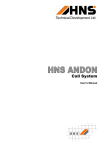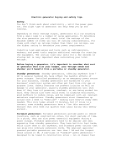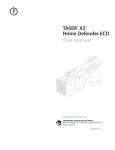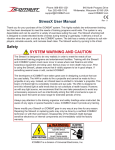Download INSITE USER MANUAL IMPORTANT NOTICE
Transcript
INSITE USER MANUAL 20 January 2010 IMPORTANT NOTICE Thank you for purchasing your INSITE Monitoring and tracking system. We strive to manufacture all our products to the highest design and production standards, however we cannot be held liable in any way for loss, theft, damage or harm to any person(s) or property arising from its use, whether used in accordance with our recommendations or otherwise. This device is provided as a "Do-It-Yourself" device for which you accept ALL responsibilities for its installation, monitoring, maintenance and use. INSITE Communications and its affiliates do not accept any responsibility for the manner or application, in which this device is utilized. INSITE Communications and its sales affiliates DO NOT accept any responsibility for the installation, programming, network provisioning, service interruption, activation and device or network performance. Any device using Public Networks is subject to the performance and dependability of the networks, which are not under the control of INSITE Communications, or affiliates. In accepting this device into service, you agree to Indemnify and hold INSITE Communications and its affiliates completely harmless from any and ALL damages (direct or indirect), expenses, costs ( including attorney fees and court costs), that may arise from the purchase, installation, programming, monitoring, function or malfunction, of the device and its accessories, in any network or application, whatsoever. INSITE Communications cannot accept responsibility as to the operation or performance of the GPS (Global Positioning System). These systems are also out of INSITE Communications sphere of control. Furthermore, INSITE Communications assume no responsibility for the legality or otherwise, in the use of this equipment for tracking persons or vehicles. Always check your local laws on this before use. This is YOUR responsibility. INSITE is intended primarily as a monitoring and vehicle/vessel tracking device. When used in a security application, it does not provide a hardened or resistant capability against hacking, defeat, breach or incapacitation, particularly when utilizing the WiPAN ( Wireless Personal Area Network). Best resistance to malicious attack, is obtained from using hard-wire switch connections, and by concealing or physically securing the INSITE unit and its accessories from any threat. INSITE Communications accept no responsibility whatsoever for any security breaches, intended or unintended, consequential from the use of this device and its accessories, in security or any other application. Insite Communications also reserve the right to modify, change or upgrade the product, its specifications, software, documentation and accessories, at any time without notice. INSITE WiPAN Remote Switch User Manual INSITE WiPAN Remote Switch Senders User Manual INSITE WiPAN is the Wireless Personal Area Network designed to provide wireless remote sensing of switch contacts. WiPAN switch Senders are independent battery operated transmitters that will sense a switch contact state and send this information to an INSITE base unit, every three minutes, or whenever the switch contacts change state. Each INSITE Base unit has an internal matching WiPAN receiver which communicates with the WiPAN sender transmitter(s). As well as permitting a contact set to be monitored, the senders provide supervised monitoring of the battery state in the WiPAN transmitter, as well as providing an internal magnetic reed switch that allows a magnet on say a door or window, to remotely trigger an alarm at the INSITE base unit. The INSITE base unit monitors each WiPAN sender for (i) (ii) (iii) Contact OPEN/CLOSED state Battery low Out of range or loss of WiPAN signal And will send the appropriate SMS message to a cellphone, as programmed by the user. Each INSITE can simultaneously monitor up to eight (8) WiPAN remote senders. It is however recommended that Hardwire connections be used wherever possible and for best results, avoid using more then five WiPANs in a local area, particularly if it is an electrically noisy location, or the WiPANs are more than about 15 to 20 feet apart. Each sender is assigned a unique switch number or ID 1 thro 8 by the user. Multiple INSITE base units can independently monitor up to eight WiPAN senders each, within a local area, by assigning each a unique WiPAN GROUP code. Up to 256 unique GROUP ID 's can be assigned. If you are in a noisy environment or senders are far apart, or have more than 5 WiPAN senders on a single INSITE unit, you may need to try assigning different switch ID's if you experience WiPANS being reported as going OFF-LINE and then re-Activating minutes later. WiPAN provides a nominal range of up to 50 to 80 feet in open areas. This however, can be severely diminished inside buildings and in areas that have many obstructions or are electrically noisy. When setting up a WiPAN, test it over several days to see what type of noises appear on the Band that may interfere with transmissions. Where this is excessive, try to use hard wired connections instead. Fig 1 shows a front view of INSITE WiPAN switch sender. Pinhole ON/OFF switch: Use a straightened out paperclip to insert into pinhole. Press to turn ON/OFF. LED: Flashing LED indicates WiPAN is active. Input Socket: Use a 3.5 mm stereo plug to connect external contact to sender input. Connect external contacts between TIP and SLEEVE connections on the plug. Antenna (not shown): Keep this dry and clear of metal objects. Fig 2. shows a rear view of INSITE WiPAN switch sender with rear cover removed. Two 1.5 volt AAA batteries and their correct installation polarity are shown. Also shown are two programmable DIP switches. The lower is a 4 switch DIP selector used to set the WiPAN switch number 1 thro 8. The upper is an 8 switch DIP selector used to set the unique WiPAN GROUP ID code. Assigning Switch numbers 1 thro 8 The 4 Switch DIP will set the switch number between 1 to 8 according to the following table: Assign only one WiPAN sender to each switch number, otherwise conflicts can result causing confusion and unpredictable operation. The fourth DIP position (4) is unused so can be either ON or OFF. Important: When setting or changing any of the DIP settings, ALWAYS remove at least one of the WiPAN batteries before doing so. Assigning WiPAN GROUP ID code The 8 switch DIP shown in Fig 2. sets up a unique Group ID code that ties a group of up to 8 remote senders to one INSITE base unit. Up to 255 codes are available and each should be assigned a different ID code for each INSITE base unit. Use the eight individual switch selectors shown below to set up any unique code combination and then enter these same switch settings into the INSITE base unit setup menu ( see INSITE manual). Switches in the UP position are ON and represented by a "1" in the setup menu. Switches in the DOWN Position are OFF and represented by a "0" in the setup menu. The following shows and example of a WiPAN Group ID code setting and how to convert it to "1" 's and "0" 's for entering into the INSITE setup menu. For this example, you would enter the following code into the INSITE setup menu. (see INSITE manual) "0 1 1 1 1 0 1 0" SPECIAL CODE If you enter all zeros for the WiPAN Group ID code, the INSITE base unit will accept signals from all WiPANs within radio range. This feature is used for troubleshooting WiPAN senders that may have bad code settings, but should NEVER be used as a permanent code setting. IMPORTANT: AVOID using SPECIAL WiPAN GROUP ID code "00000000". INSITE will reject any code that is not IDENTICAL to what is set up in the Insite base unit group code menu (except the special code 00000000) See the INSITE manual for instructions on how to set up the Group code on the INSITE base unit. Be aware of using multiple Insite base units. If any are set to the all zero Group Code, they will cross-talk with WIPAN's set to other Codes. WiPAN Operational description After you have set up the WiPAN switch number and group ID code, insert the batteries and turn the Sender ON by using a straightened out paper clip inserted into the pinhole shown in Fig1. The LED on the WiPAN sender should start blinking once every 4 or 5 seconds. If the Base unit has the WiPAN armed in the setup menu (Ref. Insite manual) and the corresponding switch DEVICE has been armed and the MASTER SMS has been enabled, the system will monitor the switch and deliver SMS alarm messages according to user settings. The base unit will show all active WiPANs (having the same group ID code) on LCD screen 2. (Ref. Insite manual) The WiPAN will send its base unit, a packet of data at regular intervals. If the INSITE base unit misses a packet, it sends a 'WiPAN switch OFF LINE' warning SMS Message to the user, along with the switch number. Insite Base unit Status screens 2 and 3 will also show the switch drop off-line. This display can sometimes take up to 13 minutes to update. This feature can be used for alarming when an asset being protected is moved away from the INSITE base unit with a subsequent loss of WiPAN signal. For example a WiPAN fixed to a boat dock with its base unit on a boat will warn if the boat is moved from the dock. Similarly a WiPAN inside a car and the base in the garage, or a WiPAN inside a valuable piece of artwork and the base nearby, will alarm when WiPAN and base unit are moved out of radio range of each other. (Beyond about 100 feet in open area, less inside buildings). LOW BATTERY If the WiPAN battery gets too low, a warning SMS message will also be sent through INSITE. MAGNETIC SWITCH Each WIPAN switch sender comes with a magnetic reed sensor built in, that will close when in the vicinity of a magnet and open when moved away. The best location for the magnet to operate the sensor is shown by a white arrowhead on the right hand edge of the WiPAN case. Hold the center of the magnet provided, near this arrowhead to operate magnetic reed switch. The magnet can be attached to any door or window, and the WiPAN switch positioned on the door/window frame adjacent to it. When the magnet is moved away from the sensor, it will send an alarm signal to the INSITE base unit. By assigning a WiPAN sender to each entry point, a complete wireless security system can be set up quickly and easily. WiPAN vs HARDWIRE The INSITE base unit will accept either a hardwire switch or a WiPAN sender switch for each of the 8 switch devices available. To stop any conflicts and collisions from occurring, INSITE will automatically give priority to the WiPAN switch sender over the hardwire switch. It will totally ignore anything on the hardwire input if it senses the presence of a WiPAN sender assigned to that same switch number. That means that if you for some reason connect a circuit up to say switch #3 using a hardwire, and then for some reason set a WiPAN switch sender up to switch #3 as well, the INSITE base unit will ignore the state of the hardware switch contacts, and only monitor the WiPAN switch. IMPORTANT: If you are trying to set up a secure monitoring system, always use hardwire switch connections and DISABLE the WiPAN monitoring using the INSITE base unit setup menu ( Ref. Insite manual). BATTERIES Always use top quality alkaline batteries in WiPAN switch senders. Mount the WiPAN units in dry locations clear of metal objects that can reduce operating range. Do not bend antenna wire. OPERATING DISTANCE WiPAN switch senders can communicate wirelessly up to 50 to 80 feet in open spaces. Inside buildings, cars and boats, this distance will be reduced. Try to mount the WiPAN with the antenna clear of walls and objects where possible. This goes for the Insite base too. The Insite base unit has the WiPAN antenna built into the rubber GSM stub. Some Insite i2 base units are supplied with an additional stainless steel wire antenna that can extend the range of the WiPAN radio link. Plug this into the socket on the top Right hand edge of the i2. A longer piece of hook-up wire connected to this antenna socket can sometimes improve signal reception in electrically noisy locations. The 433 MHz radio band can be congested and electrically noisy in some locations. There is no control or legal standing over this. You must deal with these public use bands as best you can. Avoid having the wipan and Insite antennas near cables, walls, metal surfaces or trees. All these serve to attenuate the signals. WiPAN Sender specifications FCC ID: Part 15.231 In process. Frequency: 433 Mhz Modulation: FSK Batteries: Two ( 2) AAA Alkaline Battery life: Approx One Year Input: Passive contacts ONLY. ( must not be externally energized.) Internal Reed switch ( N.O.) Activated by external magnet. Range: Approx 50 to 80 feet (20-30 Meters) in open area. Contains FCC ID SX9000RF2.This device complies with Part 15 of the FCC rules. Operation is subject to the following conditions: (1) This device may not cause harmful interference and (2) This device must accept any interference received including interference that may cause undesired operation.



















